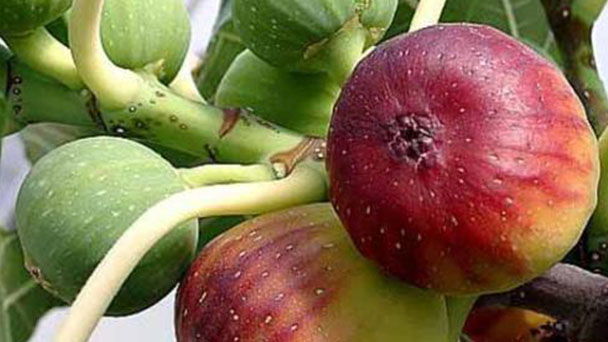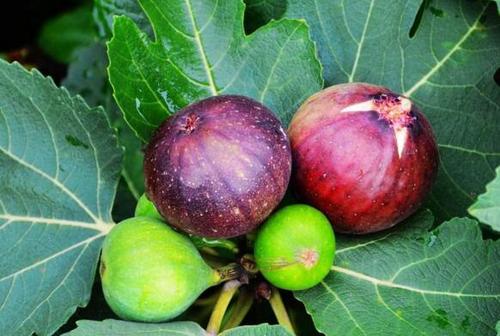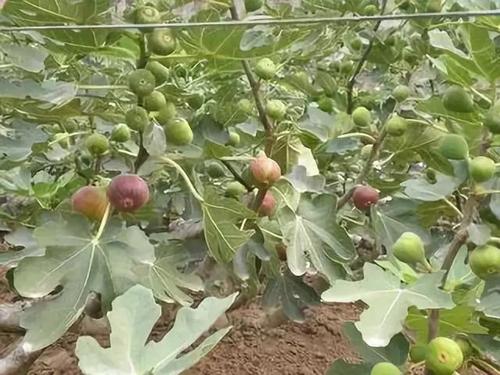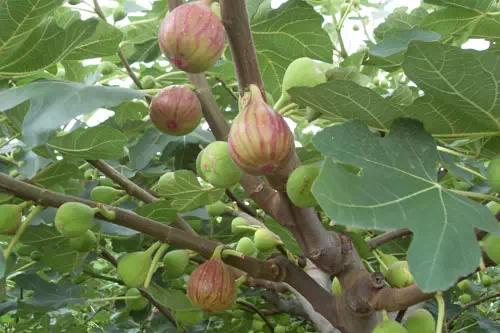Common fig profile
Written by Maggie
Jan 29 2021

The common fig (Ficus carica Linn.) is a flowering plant belonging to the genus Ficus in the Moraceae. It grows mainly in some tropical and temperate regions and is a small deciduous tree in the subtropical region. Common Fig has 800 known species, most of which are evergreen. Only those growing in temperate regions are deciduous. The fruit is bulbous and has a small hole in the tail. The pollen is carried by wasps.
Common fig picture

Common fig morphological characteristics
Common Fig (Ficus carica Linn.) is a deciduous shrub, 3-10 m tall, much-branched; Bark is grayish brown, lenticels obvious; Branchlets erect, stout. Leaves are alternate, thickly papers, broadly ovoid, nearly equal in length and width, 10-20 cm, usually 3-5-lobed, lobes ovate, margin irregularly obtuse, surface rough, abaxially dense with fine cystolaris and gray pubescent hairs, base shallow cordate, basal lateral veins 3-5, lateral veins 5-7 pairs; Petiole of Common Fig is 2-5 cm long, stout; Stipules ovate-lanceolate, ca. 1 cm long, red.
Common Fig (Ficus carica Linn.) is dioecious, male flowers and gall flowers on the inner wall of a FIG, male flowers on the inner wall of the mouth, perianth segments 4-5, stamens 3, sometimes 1 or 5, gall flowers lateral, short; Female perianth as male, ovary ovoid, smooth, style lateral, stigma 2-lobed, linear.
Ficus solitary leaf axils, large and pear-shaped, 3 -- 5 cm in diam., apically sunk, purplish-red or yellow at maturity, basal bracts 3, ovate; Achene of Common Fig is lenticular.
Common fig growing environment
Common Fig (Ficus carica Linn.) likes warm and humid climate, poor resistance, drought resistance, not cold, not waterlogging. To Xiangyang, deep soil layer, loose and fertile. It is advisable to grow on sandy soil or clay loam with good drainage.
Common Fig distribution range
Origin coast of the middle sea.Turkey to Afghanistan. Common Fig (Ficus carica Linn.) was introduced from Persia in Tang Dynasty and is cultivated in both north and south of China, especially in southern Xinjiang.
Common fig propagation methods
Common fig (Ficus carica Linn.) is propagated by cutting, division, layering propagation, especially cutting propagation.
Common fig cutting propagation
In the middle and late spring, sturdy branches with 1-1.5 cm diameter and short internodes of Common fig were selected from the excellent mother plants that had not sprouted for 3 years and had not sprouted
The cuttings of 30~50cm should be ditched according to the row spacing of 50cm, inserted into two-thirds of the soil diagonally, and the rest part exposed outside the soil. The cuttings of Common fig should be filled with compaction and watered to keep the soil moist. Summer cuttings, desirable semi-lignified green branches for cuttings. Root about 1 month after cutting. Cultivate 1 year can transplant. The cuttings can also be stored with wet sand for 1 month to form a callus and then cuttings.
Common fig division propagation
Divided planting was carried out in spring, and planting was carried out according to row spacing of (3-4) m× (3-4) m in the hole. Common fig is better to prune before planting to remove thick or dead branches and plant before the SAP flows or leaves unfold.

Common fig growing methods
Common fig management and maintenance can be potted or in the waste slope, garden, garden cultivation. For cultivated on a barren slope, garden and courtyard, the Common fig planting density can be increased by 1×2 meters and the planting pit is 50-70 centimeters deep. Diameter is 40-60 cm, with the mixture of phosphorus and potassium (such as human and livestock, poultry dung, green fertilizer, cake fertilizer, chemical compound fertilizer) and so on as the base fertilizer, the suitable period for transplanting in North China should be around the Qingming Festival, the Northeast should be around the Grain Rain, in the South Common fig can be transplanted after autumn leaves, but should avoid the flowering and bearing period.
The plastic clip
Common Fig (Ficus carica Linn.) is simple in shaping and pruning, with low requirements for pruning and shaping techniques. Generally, multi-main branches are naturally open and heart-shaped pruning, but 3-5 main branches should be kept in the whole plant without any side branches, and the main branch group should be directly grown on the main branch. During the sapling focus on cultivating the main branch, and pay attention to raise the main branch Angle, promote multiple branches, to achieve the purpose of rapidly expanding the crown. After Common fig entering the first fruit stage, we should do much to cultivate branch groups so as to promote the formation of a certain yield. In the Common fig full fruit stage, the main branches should be cultivated and the large and medium branches should be renewed. On the Common fig tree potential aging or serious diseases and insect pests, we can use the base or branch issued by the sprout tillering or hidden bud, re-culture of the main branch and branch group.
Common Fig begins in summer and matures through winter. The picking of Common Fig is usually carried out in the morning or evening on a clear day. When the ripe fruit has a small hole slightly open at the top and the skin shows the color of the native variety (multi-bonus, yellow variety), the picking should be done. Overripe fruit is not tolerant to storage and transportation after harvest.
Field management
After Common fig (Ficus carica Linn.) survives, the soil is loosened and weeding is carried out. Human excrement or ammonium sulfate was applied in June and July respectively. After planting, the canopy should be cultivated to form a layer-free tree form or a multi-main technology natural happy tree form. Generally, the trunk height of Common fig can be fixed at 50CrN, and 5~7 main branches can be retained, and the lateral branches can be selected appropriately to fill the void. After the trunk is fixed, it should be pruned every year to remove dense branches, diseased branches and dead branches. The thinning potential is mainly light shearing. Autumn fruit mainly, can be in the fruiting branch short intercept 2~3 buds, if the harvest of summer fruit mainly should not be short cut.
Common Fig (Ficus carica Linn.) fertilizer should be applied during the growth of young trees if the base fertilizer is insufficient. The method is from the taproot about 40 cm, the plant application of about 5 kilograms of decomposed manure; Potted Common fig at least 1 kg. About 15 kg of decomposed farmhouse fertilizer should be applied to mature trees, and basal fertilizer should be applied before and after falling leaves. It is better to apply topdressing in the period of new shoot flourishing and fruit rapid expansion. Common Fig is a fruit tree that is more resistant to fertilizer, but phosphorus and potassium fertilizer should be applied more heavily, and the ratio of nitrogen, phosphorus and potassium is generally 0.5:1:1. Because of Common fig drought and waterlogging resistance, it needs more water for shoots growth and fruit expansion. However, it is easy to cause falling flowers, falling fruit, falling leaves and even death if it is sodden or waterlogged for a long time. Therefore, attention should be paid to waterlogging and drainage. Potted Common fig should also pay attention to drainage, especially in the heavy rain or rain after the continuous rainy season, should pay attention to block rain or pour basin control water.
Common fig (Ficus carica Linn.) prevention of diseases and pests
Common Fig (Ficus carica Linn.) has fewer pests and diseases. In the fruit growth period, the special odor to the surrounding is easy to cause the mulberry field cattle harm; The fruit of Common fig (Ficus carica Linn.) is susceptible to birds when ripe. In addition to the artificial capture of mulberry cattle, drive away birds, can be artificial or drug eggs. You can also use a scarecrow to tie plastic stripes into the field to drive away birds.
The main value of common fig
Common fig medicinal value
The common fig (Ficus carica Linn.) can treat enteritis, dysentery, constipation, hemorrhoids, sore throat, carbuncle scabies, good for throat, appetizer and insect repellent.
For loss of appetite, abdominal distension pain, hemorrhoids constipation, indigestion, hemorrhoids, rectocele, diarrhea, lack of milk, sore throat, hot dysentery, cough sputum and other diseases.
Common fig ornamental value
Common FIG (Ficus carica Linn.) trees are elegant and ornamental trees for courtyARDS and parks. Generally, they do not need pesticides and are pure natural and pollutionless trees. Common fig leaves are large, palmately cracked, and the foliage is rough. It has a good dust absorption effect. If it is configured with other plants, it can also form a good anti-noise barrier. Common Fig (Ficus carica Linn.) trees can resist the toxic gas and air pollution that ordinary plants can not tolerate, so they are a good tree species for greening in chemical polluted areas. In addition, Common FIG has strong adaptability, wind resistance, drought resistance, salt and alkali resistance. It can play the role of windbreak and sand fixation and greening in arid desert areas.

Latest Updated
- Benefits of Bugleweed - 7 Science-backed Health Benefits
- Bugleweed Dangers & Side Effects - Is It Poisonous?
- How to Plant Evergreen Trees - What You Should Know
- When to Plant Evergreens - Grow Guide for Evergreen Trees
- 12 Wonderful Evergreen Shrubs for Your Garden
- 12 Popular Evergreen Plants with Pictures for Beginners
- When And How To Prune A Lilac Bush Like a Pro
- How to Grow & Care for Lilac Vine (Hardenbergia Violacea)
- Japanese Lilac Tree (Syringa Reticulata) Care & Propagation Guide
- Shumard Oak Pros and Cons - What to Know
Popular Articles
- Winter maintenance of Antirrhinum Majus
- How to Grow Terminalia Mantaly Tree
- How to Grow and Care for Crossostephium Chinense
- How to grow Antirrhinum Majus in spring
- Peristeria Elata (Dove Orchid) Profile: Info & Care Guide
- Underwatered Snake Plant (Sansevieria Trifasciata) - Signs And How To Fix
- How to Care for Brazilian Jasmine Plant (Mandevilla Sanderi)
- How to Grow & Care for Graptopetalum Purple Delight in Summer
- Rosa Chinensis (China Rose): Plant Growing & Care Tips
- How to Care for Baby Sun Rose (Aptenia Cordifolia)